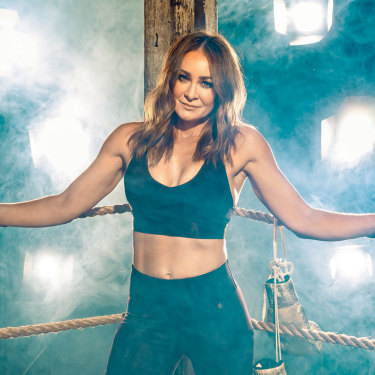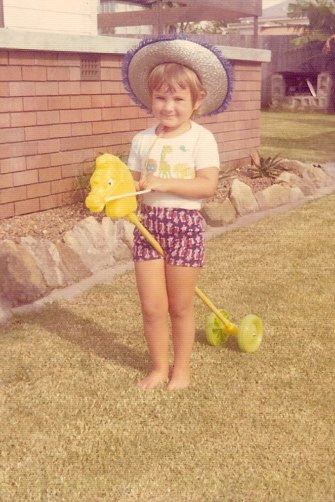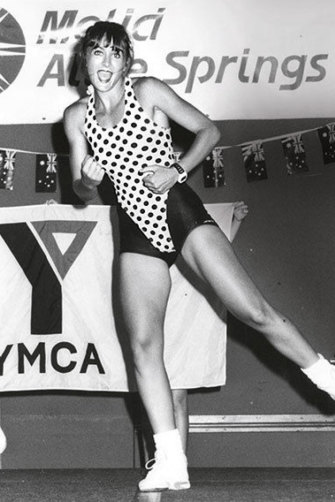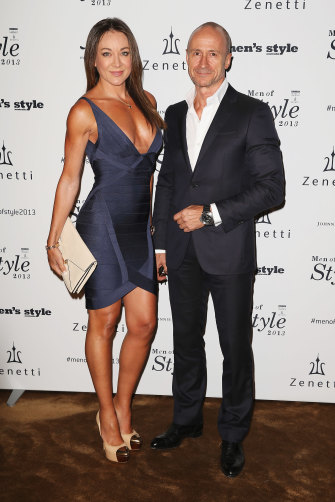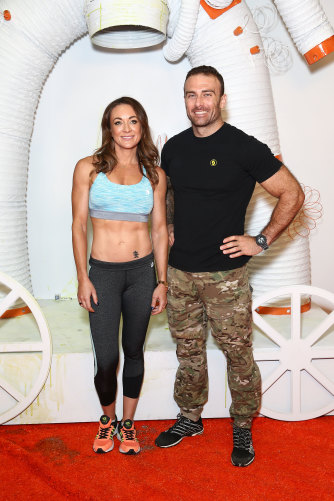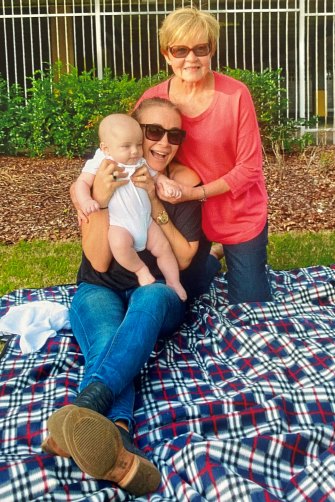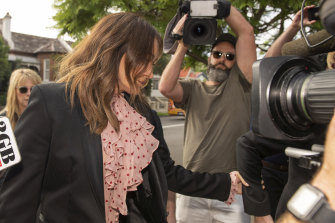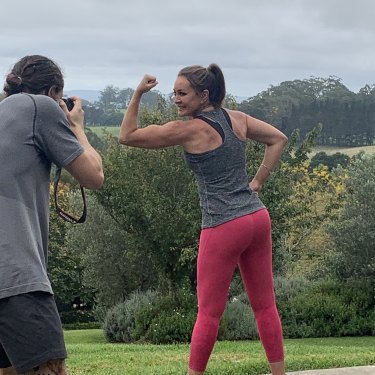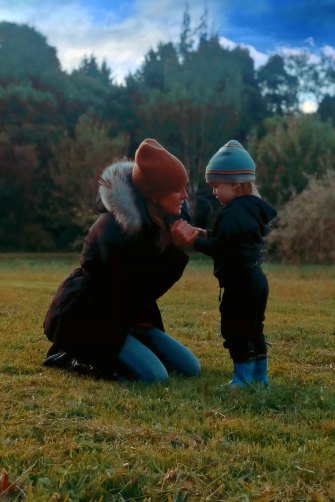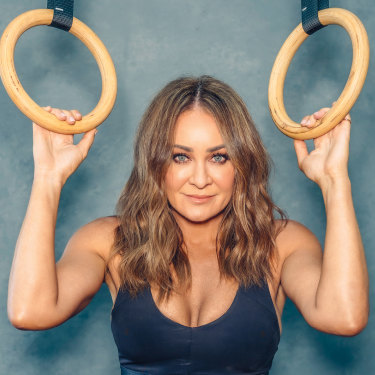‘A pretty dark place’: fitness titan Michelle Bridges on the hardest time of her life
By Jordan Baker
Michelle Bridges: “I don’t have to take a back seat with my career, but I’m not winding the beast up like I used to, and I don’t want to.”Credit:Tim Bauer
Entrepreneur John Keats has known fitness queen Michelle Bridges since the late 1990s, when she roared into Sydney in a Sportsgirl Barina with everything she owned in the boot and began working at a gym near his car dealership. He has watched her become a millionaire and a mother; fall in love and have her heart broken; and become a titan of Australian fitness before weathering the public disgrace of being caught drink-driving with her then four-year-old son Axel in the back seat.
These days, Keats, who owns a chain of Pilates studios, lives on a farm near Bridges’ property in the NSW Southern Highlands with his wife Louise. The dapper, salt-and-pepper 50-something is Bridges’ training buddy, snake-catcher and self-appointed matchmaker. After Bridges’ messy split from her most recent partner, ex-army trainer Steve “Commando” Willis, Keats wants her to find someone uncomplicated, funny and easygoing; the type who’ll bring her a cup of tea in the morning. A country bloke, perhaps. “Someone who will love her for exactly who she is,” he says. He doesn’t even need to be muscular: “A lot of guys would feel intimidated, and think, ‘I’m not fit enough, I’ve got a bit of a pot belly,’ ” says Keats. “It might have been higher on her list once upon a time, but not any more. A decent human. Someone who knows the difference between right and wrong.”
Suitors may need to adjust their perception of Bridges, too, if they still think of her as the ambitious, unyielding amazon who exhorted hundreds of thousands of Australian women to stop making excuses and kick those kilos to the kerb. Bridges, once a familiar face in Sydney’s inner-city suburb of Potts Point, now lives on four hectares with Axel and Banjo, a badly behaved cavoodle. Recently, Banjo bolted out the gate and Bridges, in gumboots and a dressing gown, had to run down the road hurling chunks of chicken to get him to stop. She fixes the ride-on mower, battles with her dangerously old oven, and goes to bed in a cardigan and beanie during winter because her farmhouse is so cold. She’s a single mum who does school pick-up, coaches the under-6s and spends hours playing with her son on the floor.
“To be honest, it was the hardest time of my life, ever, leading up to what happened. I felt like I was in a fog. I felt very alone.”
Brand Bridges lives on, as does her online fitness program, the 12 Week Body Transformation (12WBT). But the world has changed, and so has she. Gone is the frenetic pace; the drive to push further, harder, faster. Gone, too, thanks to the drink-driving conviction, is the sense that Bridges is any less flawed than the rest of us. She built her empire on the message that we can overcome the challenges in our lives by squaring up to them, then faced a relationship break-up so humiliating and public shame so devastating that even her remarkable willpower could not vanquish them.
“To be honest, it was the hardest time of my life, ever, leading up to what happened. I felt like I was in a fog,” she says. “I felt very alone.” She was broken. She remains bruised. But Michelle Bridges is bouncing back.
We’re sitting in the conference room at 12WBT’s utilitarian office in Surry Hills, in inner Sydney, talking about Bridges’ childhood. Her voice sounds like a pack-a-day smoker’s, thanks to years of shouting over music while straining to lift weights, and her eyes are a striking pale blue. She is 50 but doesn’t look it. Her hair is pulled back, and there are gold chains around her neck, a gold bracelet around her wrist and a gold ring on her pinky. She is wearing jeans, a long-sleeved T-shirt, and tall black boots – a simple, tasteful outfit, but not high fashion.
“Oh my god, she’s such a dag,” says her long-time friend, fellow trainer Sean Simpson . “She’s definitely not flashy. She’s done all the red carpets and that kind of stuff, but she’s a dag.”
Bridges was born in Newcastle, a couple of hours north of Sydney. Her electrician father broke up with her mother, Maureen, when she was four, and her relationship with him never recovered. “Sometimes I think, ‘What would it be like to have a dad?’ But it doesn’t really matter.” As a teenager she saw her mother crying during a phone call to him, took the handset and told him to piss off. She’s seen him at family funerals; there have been a few emails, but “overall, we’ve all just decided we’re living our lives, and I’ve made peace with that”.
Bridges, pictured at age 4, was raised by her mother after her parents split.Credit:Courtesy of Michelle Bridges
The 1970s were tough for single mothers. Maureen Bridges (now Partridge) paid a neighbour to take care of her two daughters after school while she worked as a secretary, but had no back-up if the girls were sick, and would have to leave them alone. “My heart goes out to her,” says Bridges. “My life – by design – has been completely manufactured the opposite way. I had all of my career, I had a child quite late in life, and now I am able to spend more time with him because I did the hard yards in the early years.”
Bridges attended five schools in 13 years, including one to the east at Nelson Bay and another to the north-west in Tamworth, and was rebuffed as an outsider at most of them. “I had a girl slap me across the face. I had food thrown at me. I had my school bag trashed twice. I remember my mum crying because we didn’t have any money, and she’s having to repair an entire school bag because everything’s been trashed inside it.” Bridges mastered the brave face that has served her well during the tabloid frenzies of her adult life. ” ‘Don’t let them see you cry. Don’t let them see you get emotional, don’t let them see any of it,’ ” she remembers telling herself. “Internally, I was in a lot of pain, but I could just shut it down. So in some parts of your life that’s a good thing to have, but probably not that healthy.”
Bridges in aerobics mode in 1994.Credit:Courtesy of Michelle Bridges
Sport was Bridges’ escape; it still is. She loved the discipline, the competition and the camaraderie. “It was my rock, my place of solace,” she says. At school, she ran aerobics classes for the students who wanted to avoid competitive sport, then expanded her enterprise to the local squash courts. “You’d never get away with it now, a 14-year-old loose on the general public,” she says.
When Bridges left school, bound for years of service as a teller at the Greater Newcastle Building Society, she popped into a Taree nightclub to inquire about a part-time job. Under the pretext of showing her around, the man led her to a dimly lit bar. Something felt wrong and she tried to leave, but he pushed her against the bar and began tearing at her clothes. Bridges fought him off and ran to the door, only to discover it was locked. He set upon her again, and again she fought until the door gave way and she was able to flee – straight to the police station. The police pressed charges, the case went to court, and the man was sentenced to a year in prison.
“ ‘Don’t let them see you cry. Don’t let them see you get emotional, don’t let them see any of it.’ Internally, I was in a lot of pain.”
She began seeing a therapist but couldn’t afford to continue the treatment. “In the end I thought, ‘I’ll have to deal with this myself,’ ” she says. “One of the things that struck me, and I’ve kind of lived by, is ‘I can’t let that person continue to have power over me. The longer it stays with me and I don’t process it and move on from it, he’s still got me.’ So I had to just gradually let it go. I never think back on it.”
When Bridges was in her early 20s, she moved to Alice Springs with an air-force boyfriend. The details about this time in her life are sketchy, and she is not in a hurry to clear them up. Having rekindled her love of sport, she worked at the Alice Springs YMCA and entered physique competitions, such as Miss NT, Miss Australasia and Miss Oceania; in photographs from the time she looks like an oiled, muscular Gidget, with a long, flicked bob, fringe and laced tartan swimsuit.
She broke up with that boyfriend, met another and married him, walking down the aisle in a November Rain-style short white dress that prompted the whole church to “wolf-whistle and carry on”, the one-time groom, Ben Dombrowski, told tabloid magazine Woman’s Day in 2013 – the height of Bridges’ fame – after becoming annoyed he’d been airbrushed out of his ex-wife’s narrative. Bridges says she doesn’t remember much about the wedding, other than her mother’s dismay that it happened at all. “The marriage didn’t end well,” she says.
“Let’s just say that it was a decision not to stay together. We were young … It was a fun wedding, I suppose. It was an interesting dress.” She laughs nervously. “I was very naive.”
When she was in her late 20s, Bridges left Alice Springs and the three-year marriage to head to Sydney and found work at a Balmain gym frequented by John Keats. “It was the typical example of the girl who comes to the city with a big dream,” says Keats, then a prestige car dealer. He was good friends with the gym’s owner, Bill Moore, a British ex-bricklayer 17 years Bridges’ senior, who would become her second husband. “She used to send VHS tapes to the networks with her training,” says Keats. “She was so focused on improving herself.”
Bridges in 2013 with her then husband Bill Moore, seen by many as a key contributor to her success.Credit:Getty Images
When Bridges arrived, the fitness industry was at a crossroads. It was the dying end of the G-string-over-tights era, when freestyle aerobics reigned but gyms were losing members because the routines – choreographed by the instructors – were so complicated. Bridges’ charisma and no-nonsense style drew bigger than usual numbers to the floor, and so her reputation grew. “You were a bit of a rock star, getting 100 people to your class,” she reflects.
Bridges was one of the first instructors to embrace a new type of aerobics pioneered in New Zealand by former Olympian Les Mills and loosely based on Jazzercise. “[It was] pre-choreographed,” says Sean Simpson. “Everyone got to know the moves … you knew what you had to do in each class, it took away all the angst.” Les Mills instructors wore black and meant business. Beginners, new members and even straight men returned to the aerobics floor.
Bridges became one of a dozen master trainers, teaching Les Mills workouts to gym teachers across the world. “To be considered a master trainer, you were a god-like figure,” says Simpson. “If you worked in the industry, you knew their names.” For many, it was the ultimate achievement. For Bridges, it was not enough. Her next ambition was television.
Simpson has never met anyone as driven. “If you’d identify what it was, you’d bottle it, sell it and you’d make a motza,” he says. “It’s who she is. It’s intrinsic … It’s there and it hasn’t left her.”
Bridges with Steve Willis. Their relationship ended in early 2020.Credit:Getty Images
With her new partner Willis – a handsome former army trainer who had three children to two women – and on falling pregnant with Axel at 44, Bridges did not want to make that mistake again. She took her foot off the accelerator. “In some ways, some were not happy about that because [the business] was such a juggernaut and there were other people involved,” she says. “But I was the face of it, and that was a lot.” Moore sold out of 12WBT in 2015, and the other two major shareholders followed in 2018. Bridges, who appears wary of talking about the business split, is now the sole director.
12WBT may have led the online fitness revolution in Australia, but it is now jostling with imitators seeking a slice of the market. They include Hollywood star Chris Hemsworth’s six-week Thor Workout and former Bachelor star Sam Wood’s 28-day program. The new queen of Australian fitness is Adelaide mum Kayla Itsines, who zoomed past Bridges to collect 12.8 million Instagram followers – Bridges has 281,000 – and who was estimated to be worth almost $500 million before she, too, separated from her husband and business co-founder, Tobi Pearce, last year.
Trends in fitness have also changed, with the shouty boot camps and “go hard” philosophy of which Bridges was once queen replaced by wellness and body positivity. Even Weight Watchers has rebadged itself WW (Weight loss and Wellness) with a focus on more than just slimming down.
After boasting a staff of more than 40 and at least 20,000 participants in each monthly round in 2014, 12WBT now employs 20 people, and about 22,000 sign up to the original $200, 12-week program a year. It has widened its offering to incorporate programs for pregnancy, for men only, and a “continuous lifestyle plan”, trying to remain relevant while the industry changes.
Bridges’ first Mother’s Day, in 2016, with baby Axel and mum Maureen.Credit:Courtesy of Michelle Bridges
On January 26, 2020, Bridges was driving Axel to the beach in her Range Rover when, at about 11.30am in Bellevue Hill, a wealthy suburb in Sydney’s east, police signalled her to pull over for a random breath test. She initially hit her brakes and changed lanes, then Bridges told officers she’d used mouthwash five minutes earlier and drunk alcohol the previous night.
According to court documents, “Police noted [she] appeared nervous, her hands were shaking and her voice was trembling.” She registered a blood alcohol reading of 0.086, at the low end of a mid-range offence which carries a mandatory licence suspension.
News outlets jumped on the story. Not only was it a case of drink-driving involving a child passenger, but this was Michelle Bridges, the woman whose multi-million-dollar fortune was built on helping people rein in their indulgences. The next day Bridges issued a statement saying she was devastated and embarrassed about her “inexcusable” behaviour. She also revealed that, a few weeks earlier, she had broken up with Willis, and said that emotional turmoil had contributed to her driving under the influence.
She cannot discuss the details of the split due to legal proceedings in Family Court, but it floored her. “There were things that were very challenging in that,” she says, as tears roll down her cheeks. “And humiliating. And there was a lot of stuff I didn’t know. So that night [before the drink-driving incident], I had a couple of girlfriends around. Obviously we were drinking … it was as simple as that. And then the next morning, I made a very bad decision to get in the car. I was eight kilos lighter than I normally am. I’d been extremely stressed and not sleeping.
Bridges arriving at court last year to face a charge of drink-driving, which followed what she describes as “the hardest time in my life”.Credit:Rhett Wyman
“I felt very alone. You’re putting on a brave face, and ‘I’m good, I’m fine’. So from the outside looking in, other than my very close friends and family, no one would have known what was going on for me, and for us. It was a challenge. To be honest, it was the hardest time of my life, ever, leading up to what happened. I felt like I was in a fog, and I didn’t know what was happening. I didn’t understand.
“On Australia Day, I was pulled over … I was already in a pretty dark place. Then, you know, even more shame and humiliation came with that. The most important thing that came out of that – I hate crying,” she says, as she mops up more tears with a tissue, “was the incredible outpouring of people, colleagues, friends, people I’d worked with, strangers, my team – because I’ve always probably been that kind of person, as I explained to you before, to put my walls up.” She pauses, as the tears continue.
“That was the first time I’d publicly shown vulnerability, which was, actually, a year down the track, actually a frigging awesome thing. Because I let people in … Rather than trying to quickly fix it, find a solution, work it out, manage it, I just went with it. It was a good thing. It showed me the kindness of people.”
Dozens of other spurned, humiliated and devastated women reached out to her, sharing their own stories. “Some of them had me laughing my head off,” Bridges says. “Some lady told me about a crazy story with her ex – there were underpants being burned – the stories were hilarious and very comforting. The fact people took time to sit down and write me a letter was a very humbling experience. I felt, ‘I have to own this, I have to step up and own this, and then move on.’ ”
In February 2020, Bridges was fined $750 and banned from driving for three months. She also had to put an interlock device on her car for a year, which
required her to pass a breath test every time she wanted to turn on the ignition.
Simpson says those months were harrowing. “Seeing her broken,” he says. “It was terrible to see your best friend go through that. You know when you’re pushed to your absolute limit and think, ‘Surely I can’t take any more.’ And then something else happens.”
The drink-driving charge divided Bridges’ fans. Some were appalled, others forgiving. Melbourne woman Julie Hoffmann had been a depressed, 115-kilogram smoker when she signed up for the first-ever 12WBT round in 2010, and proceeded to lose 43 kilograms, became a personal trainer, and set a world burpee record (40 in a minute).
“I started boxing at 50. I do stupid things,” she says self-deprecatingly, “and a lot of it is thanks to her. I didn’t really have anyone believe in me before her.” After news of Bridges’ driving charge broke, Hoffmann took herself off social media. “I hate how terrible humans can be to other humans when they don’t really know what’s going on behind the scenes,” she says. “We all stuff up at some point. There were so many people bagging her out, and back when she was big on the program, she could do no wrong. I thought, ‘You ungrateful people.’ It didn’t alter how I felt about her.”
“That type of trauma takes a while to recover from … I admire her strength, it could have broken a lot of other people a lot harder.”
Then the coronavirus pandemic hit, and Australians had other things to worry about. Bridges sold her Potts Point apartment and retreated to her Southern Highlands property. “She’s definitely still recovering; that type of trauma takes a while to recover from,” says Simpson. “Anyone would take their sweet time to recover from that and everyone recovers differently. From my perspective, she’s doing great. I admire her strength, it could have broken a lot of other people a lot harder.”
Bridges at home in the NSW Southern Highlands, where she is now co-coach of a local under-6s rugby team, runs a small farm and keeps school-friendly work hours.Credit:Courtesy of Michelle Bridges.
Bridges never wanted a baby when she was with Moore, who has grown-up children. “He would always say to me, ‘If you want to have kids, we can do it,’ ” she says. “But it was never, ‘Let’s do it together’. I think he wasn’t really keen but would do it for me. I didn’t know if that was enough to get me over the line. Plus, business and career – it was incredible. When I was with Axel’s dad, the conversation came about. And I was excited by the prospect. It felt different.”
John Keats’ wife Louise wondered how Bridges would take to motherhood. “With Billy she had a dog, but he was the primary carer of the dog,” she says. “She was not a clucky woman. I thought, ‘Is she going to be able to do this?’ ”
Turns out, Bridges could. Axel spends most of his time with his mother. “She does very much the lion’s share of the parenting,” says Louise. “Axel is her first priority and the next is daylight.”
Bridges with Axel in 2018. Credit:Courtesy of Michelle Bridges
Axel likes trains and Lego and books. He has his mother’s striking blue eyes. Bridges tries to avoid using babysitters, and keeps school-friendly work hours where possible. She takes Axel to swimming, karate and rugby union. She is the co-coach of his Bowral Blacks under-6 team, alongside a former representative for a South African Super Rugby team. “They are very over-qualified,” says Keats. “It’s like herding cats.”
Louise Keats’ mother was the sole daughter of a single mum (cooking writer Margaret Fulton), and she understands the bond. “It’s an intense relationship,” she says. “Axel is in no doubt his mother loves him. They are together all the time. She doesn’t mind sitting on the floor for hours with him, in a way that most of us find mind-numbingly boring. Sometimes I wonder how her wheels don’t fall off. She runs the house. She’s running the business. She’s also running a small farm, and dealing with the odd snake and the mower breaking down.”
Michelle Bridges: “I had all of my career, I had a child quite late in life, and now I am able to spend more time with him because I did the hard yards in the early years.”Credit:Tim Bauer. Hair and make-up by Simone Forte. Bridges wears MB activewear available at Big W.
The drive that helped propel Bridges to stardom has not gone; it’s just focused on different, perhaps more rewarding things. Bridges’ force of will, which saw her through a sometimes difficult childhood, drove her to wealth, influence and fame. But when she got there, she realised it was not quite where she wanted to be. Then, like so many women before her, motherhood shifted the tectonic plates of Bridges’ world. Perhaps Bill Moore’s description, eight years ago, of Bridges as “everywoman” is even more apt now than it was then.
“I didn’t have a child at 45 not to be with him,” she says. “You’re not serving yourself or anybody else around you if you are unhappy, or not living the kind of life you would like. I don’t have to take a back seat with my career, but I’m not winding the beast up like I used to, and I don’t want to.” As for Keats’s dream of pairing her with a country bloke: “I don’t think I’m really there yet. But let John have his Cupid fun and you never know what happens.”
To read more from Good Weekend magazine, visit our page at The Sydney Morning Herald, The Age and Brisbane Times.
Have a Good Weekend all week
We deliver the best of Good Weekend to your inbox so it’s there when you’re ready to read. Sign up for the Herald‘s Good Weekend newsletter here and The Age‘s here. Sent every Saturday.
Most Viewed in Lifestyle
Source: Read Full Article

